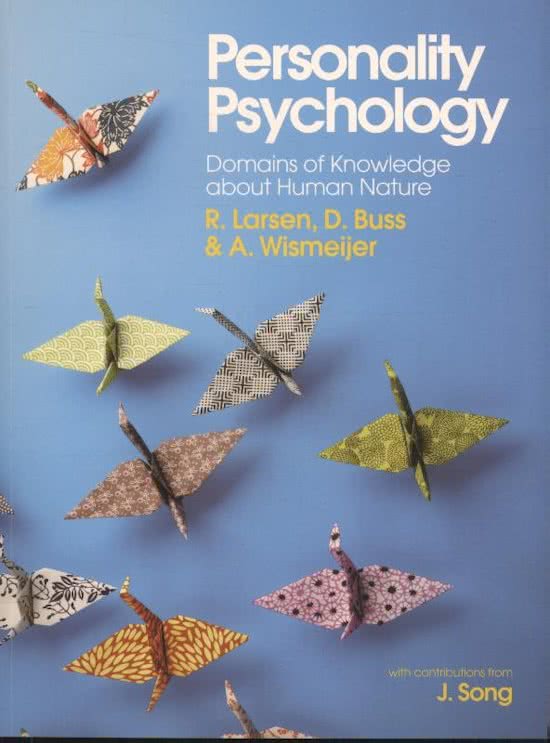, mN€EeEEyPpss
PREM
Yellowing
aim
describing differences and relating them
•
:
→
interpersonal
→ intra personal
=D
multiple types of differences at different levels
=D describe relationship between differences
Los self esteem and
e.
g .
.
aggression
types of differences
•
→ traits
→ motives
D emotions ( positive , negative ; durations ,
fluctuations )
→ self
inter individual differences C between individuals )
•
•
intergroup differences C between groups )
LD
types of possible
many groups
intra individual differences C within individuals )
•
↳ situation , time ,
etc .
•
inter individual differences in intraindivi dual differences
I individuals
↳
comparing consistency changes within
between different individuals
°
explanation of differences
→
proximal explanation
↳ factors that co
-
occur in time with the
Phenomena you want to explain
→
distal explanations
↳ factors that are further away in time
↳ e.g .
past or evolutionary past
,• the
history of
personality psychology
-
D descriptions in ancient Greece
-
D tests in China
→
Theophrastus C 327 BC -
287 BC )
↳ student of Plato
"
"
↳ collection of personality sketches C Characters =
personality types )
↳
primitive description of personality traits I types
th
→ ng century
b Galton ,
Cattell
→ individual differences
↳ Binet
-
D Stanford -
Binet test
↳ William James , Sigmund Freud
ideas PTSD in recruitment
→
;
→ 1937 : Gordon Allport
↳
starting point
"
Psychological
"
↳ Interpretation
Personality : A
, TAPPERS
CH A
#hTrR$uUEThiONm
.
AHtzPp*gethOC0GIlogy
A 17
p
-
.
TRAIT -
DESCRIPTIVE ADJECTIVES
~
Adjectives that can be used to describe characteristics
of people .
•
they refer to different aspects of people ( e.g their inner
-
.
qualities ,
their effect on other people ,
their relation to
others ,
etc .
)
PERSONALITY
~
Personality is the set of psychological traits and mechanisms
within the individual that are organized and relatively
interactions
enduring and that influence his or her
with
,
and adaptions to , the intrapsyohic , physical and
Social environment .
PSYCHOLOGICAL TRAITS
Characteristics that describe people
~
ways in which are
different from each other .
-
• traits describe the average tendencies of a person
•
How traits are there ?
many
Is
:÷÷;a÷ :*
How the ?
traits organized
°
are
out .
:÷÷÷÷÷÷÷:÷÷÷
:&
:
.
-
a
Personality is useful in
describing .
explaining and
predicting differences between individuals .
PSYCHOLOGICAL MECHANISMS
Psychological like traits but refer
~
mechanisms are ,
more
to of
the
processes personality .
No
inputs ,
decision rules and Outputs
b.
key elements of a psychological mechanism
, WITHIN THE INDIVIDUAL
Personality herself
~
with
is
something a person carries him or
Over time and from one situation to the next .
ORGANIZED
~
The psychological traits and mechanisms ,
for a given
person ,
are not simply a random collection of elements .
Personality is organized because the mechanisms and
traits are linked to one another in a coherent fashion .
ENDURING
~
Psychological traits are relatively enduring over time ,
particularly in adulthood , and are somewhat
consistent over situations .
Be some situations be overpowering and suppress
-
may
the of traits
expression psychological
INFLUENT AL FORCES
~
Personality traits and mechanisms can have an effect
on people 's lives Personality influences how we act ,
.
how we view ourselves ,
how we think about the world
,
how we interact with others ,
how we feel ,
how we
select our Social ) environment , what goals and
desires we pursue in life and how we react to our
circumstances .
PERSON -
ENVIRONMENT INTERACTION
~
Interactions with situations include perceptions . selections ,
evocations and manipulations .
Two people may be
exposed to the same objective event ,
yet what they
pay attention to and how they interpret the event
may be very different .
•
perceptions how interpret the environment
-
: we see and
selections i the manner in which we choose situations to enter
evocations :
the reactions we produce in others
manipulations the in which intentionally attempt to
:
ways we
influence others





